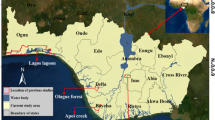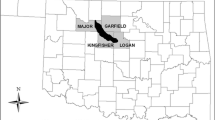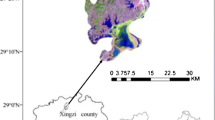Abstract
In this paper, we report the first wetland mapping of the entire China using Landsat enhanced thematic mapper plus (ETM+) data. These data were obtained from the Global Land Cover Facility at the University of Maryland spanning from 1999 to 2002. A total of 597 scenes of Landsat images were georeferenced and mosaiced. Manual image interpretation of satellite images was aided with elevation data, soil data, land cover/land use data and Google Earth. The minimum mapping unit is 10 pixel × 10 pixel, equivalent to 9 ha. The aim of our first round of mapping was only targeted at the boundary delineation of any type of wetland except those wetlands that are under agricultural use (i.e., paddy fields), which has already been well mapped by others. Our interpretation results indicate that a total of 359478 km2 of wetlands are of non-agricultural use. Among our preliminarily mapped wetland, 339353 km2 are inland wetland, 2786 km2 are non-agricultural artificial wetland, and 17609 km2 are coastal wetland. Because low-tide is rarely captured in satellite images, an under-estimation of coastal wetland is inevitable. We conducted some statistics based on our mapped wetlands and compared them with those previously obtained from a number of sources including a land cover/land use map made with satellite images during the late 1990s and early 2000s, a marshland map developed in approximately the same period, survey data of coastal wetland in early 1980s, and area data for approximately 400 larger patches of marshland in China compiled in 1996. Because some inconsistencies exist in the guidelines of those different wetland surveys, difference in area is expected. Some further comparison indicates that the wetland distributions derived from the preliminary wetland map are reasonable and more objective than other sources. The mapping process also indicated that the method adopted by us was efficient and cost-effective. We also found that in order to ensure comparability of the wetland maps developed at different times, a set of standard guidelines on the wetland categories to be mapped, and the mapping methods to be used must be well conceived, developed and effectively employed. We carried out some initial geographical analysis on the distribution of wetlands.
Similar content being viewed by others
References
Mitsch W J, Gosselink, J G. Wetlands. New York: John Wiley & Sons, 1993
Brinson M M, Malvarez A I. Temperate freshwater wetlands: Types, status, and threats. Environ Cons, 2002, 29(2): 115–133
Dahl T E. Wetlands Losses in the United States 1780’s to 1980’s. US Department of the Interior. Washington, D.C: Fish and Wildlife Service, 1990
Davidson N C, Laffoley D, Doody J P, et al. Nature Conservation and Estuaries in Great Britain. Peterborough Nature Conservancy Council, 1991
Hou W, Kuang W H, Zhang S W, et al. Analysis of cultivated land reclamation process and the ecological effects in north of Sanjiang Plain from 1950’s (in Chinese). Ecol Environ, 2006, 15(4): 752–756
Johnson R M, Barson M M. Remote-sensing of Australian wetlands: An evaluation of Landsat TM data for inventory and clas- sification. Australian J Mar Freshwater Res, 1993, 44(2): 235–252
Toyra J, Pietroniro A. Towards operational monitoring of a northern wetland using geomatics-based techniques. Remote Sens Environ, 1997, (2): 174–191
Wright C, Gallant A. Improved wetland remote sensing in Yellowstone National Park using classification trees to combine TM imagery and ancillary environmental data. Remote Sens Environ, 2007, 107(4): 582–605
Liu H Y, Lue X G. Study on classification system of middle scale landscape ecology mapping in the Sanjiang Plain (in Chinese). Sci Geogr Sin, 1999, 19: 432–436
Zhang B. Application of remote sensing technology on research of the wetland in China (in Chinese). Remote Sens Tech Appl, 1996, 11: 68–711
Wilen B O, Bates M K. The US-Fish-and-Wildlife Services National Wetland Inventory Project. Vegetatio, 1995, 118(1–2): 153–169
Zhang S Q. Introduction of marsh database in China (in Chinese). Geogr Sci, 2002, (2): 189
Ramsar Convention Implementing Office of State Forestry Administration, P. R. China. Guide on Implementing Ramsar Convention in China (in Chinese). Beijing: China Forestry Press, 2001. 16–17
Semeniuk C A, Semeniuk V. A geomorphic approach to global classification for inland wetlands. Vegetatio, 1995, 118: 103–124
Cowardin L M, Carter V, Golet F C, et al. Classification of wetlands and deepwater habitats of the United States. U. S. Department of the Interior, Fish and Wildlife Service, Washington, D.C. Jamestown, ND: Northern Prairie Wildlife Research Center Home Page. http://www.npwrc.usgs.gov/resource/1998/classwet/classwet.htm (Version 04DEC98)
Cowardin L M, Golet F C. US-Fish-and-Wildlife-Service 1979 Wetland Classification-A Review. Plant Ecol, 1995, 118(1–2): 139–152
Scott D A, Jones T A. Classification and inventory of wetlands: A global overview. Vegetatio, 1995, 118: 3–16
Kwi-Gon, Mi-Young Park, Hee-Sun Choi. Developing a wetland-type classification system in the Republic of Korea. Landscape Ecol Eng, 2006, 2: 93–110
Pressey R L, Adam R. A review of wetland inventory and classification in Australia. Vegetatio, 1995, 118: 81–101
Shaw S P. Fredine C G. Wetlands of the United States Their Extent, and Their Value for Waterfowl and Other Wildlife. U.S. Department of Interior. Washington D C: Fish and Wildlife Service, circular 39, 1956. 67
Gopal B, Sah M. Inventory and classification of wetlands in India. Vegetatio, 1995, 118: 39–48
Liu H T. Definition and types of wetland (in Chinese). Chinese J Ecol, 1995, 14: 73–77
National Wetlands Working Group. The Canadian Wetland Classification System, 2nd ed. Wetlands Research Centre. Ontario: University of Waterloo, 1997
Ni J R, Yin K Q, Zhao Z J. Comprehensive classification for wetlands: I classification (in Chinese). J Nat Res, 1998, 13
Tang X P, Huang G L. Study on classification system for wetland types in China (in Chinese). Forest Res, 2003, 16: 531–539
Liu Z G, Ma X H. Classification of wetland (in Chinese). Wetland Sci Manag, 2006, 2: 60–63
Chen J W, Huang G L. Research of wetland classification system and indexes in China (in Chinese). Manag Forestry Res, 1995, (5): 65–71
Ozesmi S L, Bauer M. Satellite remote sensing of wetlands. Wetlands Ecol Manag, 2002, 10: 381–402
Yang B G, Wang Y, Zhu D K. The tidal flat resource of China (in Chinese). J Nat Res, 1997, 12(4): 307–316
Lei K, Zhang M X. The wetland resources in China and the conservation Advices (in Chinese). Wetland Sci, 2005, 3(2): 81–86
Lu J J. Ecological significance and classification of Chinese wetlands. Vegetatio, 1995, 118: 49–56
Zhao K Y. Chinese Marshes (in Chinese). Beijing: Science Press, 1999
Lu J J. China Wetland. Shanghai: East China Normal University Press, 1990
Chen J, Lu L Y. Ining status and the resources sustainable using Discuss of the tidal flat in Jiangsu (in Chinese). Mar Sci, 2001, 25(10): 23–25
Liu Y Z, Wu C L, Ma X. Studies on the development and utilization of shoal land in Jiangsu province (in Chinese). J China Agricul Res Reg Plan, 2004, 25(3): 6–9
Chen J W, Mei A X, Yuan J H. Using of land resources in Shanghai in consideration of seashore beach changes (in Chinese). Shanghai Geol, 2005, (9): 18–21
Shi X Z, Yu D S, Warner E D, et al. A framework for the 1:1000000 Soil Database of China. In: Proceedings of the 17th World Congress of Soil Science, Bangkok. 2002, 1757(1–5)
International Panel on Climate Change. Land-use, land-use change, and forestry. In: Watson R T, Noble I R, Bolin B, et al, eds. Land-use, Land-use Change, and Forestry: A Special Report of the Intergovernmental Panel on Climate Change (IPCC). Cambridge: Cambridge University Press, 2000. 1–51
Wang S Q, Zhou C H. Estimating soil carbon reservoir of terrestrial ecosystem in China (in Chinese). Geogr Res, 1999, 18(4): 349–356
Yu D S, Shi X Z, Wang H J, et al. Regional patterns of soil organic carbon stocks in China. J Environ Manag, 2007, 85: 680–689
Liu Y H, Niu Z. Regional land cover image classification and accuracy evaluation using MODIS data. Remote Sens Tech Appl, 2004, (25): 217–224
Shi X Z, Yu D S, Warner E D. Cross-Reference System for Translating Between Genetic Soil Classification of China and Soil Taxonomy. Soil Sci Soc Am J, 2006, 70: 78–83
Hou X Y. Vegetation Atlas of China (in Chinese). Beijing: Science Press, 2001
Author information
Authors and Affiliations
Corresponding author
Additional information
Supported by National High-Tech Research and Development Plan (Grant No. 2006AA12Z112) and the National Science & Technology Pillar Program (Grant No. 2006BAJ10B02)
Rights and permissions
About this article
Cite this article
Niu, Z., Gong, P., Cheng, X. et al. Geographical characteristics of China’s wetlands derived from remotely sensed data. Sci. China Ser. D-Earth Sci. 52, 723–738 (2009). https://doi.org/10.1007/s11430-009-0075-2
Received:
Accepted:
Published:
Issue Date:
DOI: https://doi.org/10.1007/s11430-009-0075-2




